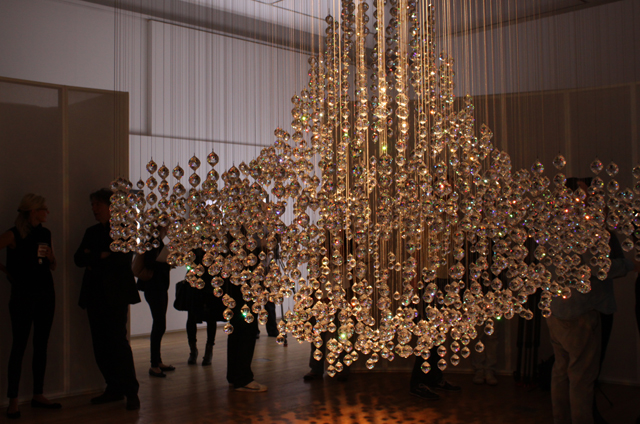Digital Crystal: Swarovski at the Design Museum

When we think of Swarovski we think beauty, elegance, fashion and decadence. Well, with the opening of Digital Crystal: Swarovski at the Design Museum, we can add intelligent, technological and advanced to that already impressive list.
Open from 5th September until 13th January on the Design Museum’s second floor, Digital Crystal invites us to experience our altering connection to physical objects in favour of virtual mechanisms of memory, experience and interaction. Comprising of 15 installations, all of which utilise the signature Swarovski glass-cutting techniques, the exhibition is as beautiful as it is thought-provoking and guides us on an intellectual journey through different artist responses, opinions and thought processes which have all manifested from the same brief showing ultimately the power we all still possess over our own thoughts regardless of the world’s changing physicality.
Swarovski, who pride themselves on being a forward-thinking company pushed by the creative industry and those with whom they collaborate, have worked with creatives to push the boundaries of what can be done with crystal for a decade and Digital Crystal most definitely does not disappoint. Working with prestigious artists such as Ron Arad and Maarten Baas as well as lesser-known but just as exciting artists Anton Alvarez and Hilda Hellström, the exhibition is a true representation of creative minds across the board. The collaboration between Swarovski and the Design Museum brings the medium of crystal directly into the design spotlight and showcases a multitude of creative applications which, in Deyan Sudjic’s (the Design Museum director) words, “questions our relationship with the changing world…the personal possessions we once held so highly are now online, or gone in an instant.”
Easily the most striking piece in the exhibition is that of artist duo Fredrikson Stallard with the huge digitally programmed installation Pandora that manoeuvres itself in and out of a classic chandelier formation. Using no lighting within, nearly 2000 crystals react with their surroundings to create a shimmering utopia of colour. Depicting the fragility of objects as physicality, the installation shows a literal breakdown of the system of an object and the power of technology to reform it through memory. The collaboration between Patrik Fredrikson and Ian Stallard provides an emotive viewing experience and is an object of outstanding beauty which absolutely has to be viewed in person to gauge the full effect of, possibly highlighting the necessity of the physical.
Paul Cocksedge’s Crystallize, first produced in 2005, was recrafted for the exhibition. The installation uses lasers that react with mirrors to illuminate a single crystal suspended, this in turn projects an outline of a classic diamond shape. Primarily an illusion, without the laser and the use of smoke, the installation would present nothing more than an unlit suspended crystal therefore prompting notions of the uncertainty of that which we know to be real and, that which we know is not.
Many of the installations are interactive pieces showing how connected we now are to a virtual world and to virtual technologies. Ron Arad’s Lolita chandelier is constructed of approximately 2000 Swarovski crystals that engulf over 1000 white LEDs, the purpose of this being to create an interactive memory. This is done through the use of SMS messages and tweets sent to the installation via #DigitalCrystal or +44 (0)7860021492 which, once received, are displayed on the chandelier.
The exhibition is rich with exciting works from artists spanning the globe. Troika’s Hardcoded Memory explores the fluidity of forgetting by projecting low resolution portraits using 850 Swarovski lenses, symbolic patterns crafted by rAndom International’s Study for Sunlight Video connect us with our personal memories and imagination and Hilda Hellström’s The Monument conveys her own memories and journey through the use of a beautifully crafted landscape and digital topography. An eye-opener, the thoughtful and engaging exhibition is certain to keep you enthralled throughout.
Ruth Page
Digital Crystal: Swarovski is at the Design Museum from 5th September 2012 until 13th January 2013. For further information or to book visit the Design Museum’s website here.























Facebook
Twitter
Instagram
YouTube
RSS